Sapientza island - unique destination for your outside vacations and also hunt for Kri Kri ibex
Sapientza island - unique destination for your outside vacations and also hunt for Kri Kri ibex
Blog Article

To many people, The Peloponnese peninsula on the Greek Mainland is the 'genuine' Greece, where things have not changed a lot in all over the centuries although that many individuals have uncovered it. This is a location where you might easily spend a month or even more however if you are short on schedule after that our hunting and also exploring Peloponnese Tours from Methoni is a fantastic option. The Peloponnese peninsula has something for every person with its many different activities as well as destinations.

The number of tags varies as well since the ibex population is ever-changing. The Kri-Kri, despite being the smallest ibex in terms of body weight (Capra Aegagrus Cretica), has long. A few specimens that were not counted determined 115 centimeters. The gold trophy is 61 centimeter (24 inches) in size. Searching of Kri-Kri ibexes, is currently permitted on Atalanti as well as Sapientza in Greece (Capra Aegagrus Cretica). Starting on Atalanti in the last week of October as well as the initial week of December, ibex hunting is allowed. Hunting is permitted the whole month of November in Sapientza, as long as the climate agrees with.
When you show up in the Peloponnese peninsula is the strikingly stunning landscape, the very first thing you will discover. The mountains, lakes, rivers, and forests make this location a nature fan's heaven. There are also lots of opportunities for treking, fishing, swimming, and also other outside tasks. The Peloponnese peninsula is not simply about its natural appeal; there are also numerous historical and cultural sites to check out. Do not forget also fishing, free-diving and also searching. Some of one of the most popular traveler destinations in the Peloponnese consist of old Olympia, Epidaurus, Mycenae, and also Sparta. These locations provide a remarkable glimpse into Greece's abundant background and also society. If you want finding out more concerning Greek folklore, after that you will most definitely intend to see Mount Olympus, residence of the 12 Olympian gods. Of course, no trip to Greece would certainly be complete without trying some of the scrumptious food. The Peloponnese peninsula is residence to some of the very best olive oil on the planet as well as feta cheese, olives, honey, and red wine. Ensure to try a few of the neighborhood specialties such as dolma (stuffed grape leaves), Souvlaki (barbequed meat skewers), and also Gyro (meat covered in pita bread).
If you're trying to find a genuine Greek experience, after that look no more than our outside hunting in Greece with fishing, and also free diving scenic tours of Peloponnese. This is an extraordinary way to see every little thing that this fantastic region has to provide. Book your tour today!
What is the diference between Kri Kri ibex, Bezoar ibex and hybrid ibex
The kri-kri is not thought to be indigenous to Crete, most likely having been imported to the island during the time of the Minoan civilization. Nevertheless, it is found nowhere else and is therefore endemic to Crete. It was common throughout the Aegean but the peaks of the 8,000 ft (2,400 m) White Mountains of Western Crete are their last strongholds–particularly a series of almost vertical 3,000 ft (900 m) cliffs called ‘the Untrodden’—at the head of the Samaria Gorge. This mountain range, which hosts another 14 endemic animal species, is protected as a UNESCO Biosphere Reserve. In total, their range extends to the White Mountains, the Samaria National Forest and the islets of Dia, Thodorou, and Agii Pandes.
This Ibex is NOT a diminutive form of the Bezoar Ibex, which has migrated into the western-most reach of the range of this species. The kri – kri (Capra aegagrus cretica), sometimes called the Cretan goat, Agrimi, or Cretan Ibex, is a feral goat inhabiting the Eastern Mediterranean, previously considered a subspecies of wild goat. The kri-kri has a light brownish coat with a darker band around its neck. It has two horns that sweep back from the head. In the wild they are shy and avoid tourists, resting during the day. The animal can leap some distance or climb seemingly sheer cliffs.
“The agrimi goat Capra aegagrus cretica is unique to Crete and its offshore islands. It has been identi®ed as a sub-species of the wild bezoar goat Capra aegagrus aegagrus Erxleben, 1777, which it closely resembles in horn shape, body form and coloration. This classi®cation has been disputed by some researchers who claim that the agrimi are feral goats, derived from early domestic stock brought to the island by the ®rst Neolithic settlers. In order to clarify this issue, DNA analyses (cytochrome b and D loop sequences) were carried out on tissue of live and skeletonized agrimi and compared to sequences of wild and domestic caprines. Results conclusively show the agrimi to be a feral animal, that clades with domestic goats (Capra hircus) rather than with wild Asiatic bezoar. This study demonstrates that morphometric criteria do not necessarily re¯ect genetic af®nities, and that the taxonomic classi®cation of agrimi should be revised.”
Report this page